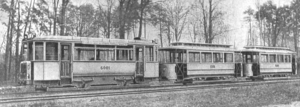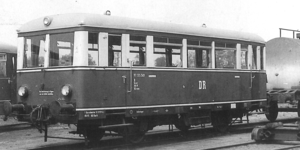BSt 6001 to 6003
| BSt 6001 to 6003 OHE T 1 to T 3 DR VT 135 501 to 503 |
|
|---|---|
|
Original state
|
|
| Numbering: | BSt 6001–6003 BVG 8001–8003 OHE Tw 1 – Tw 3 DR VT 133 501–503 |
| Number: | 3 benzene railcars |
| Manufacturer: | LHW (6001, 6002) , DWD (6003) , NAG , AEG |
| Year of construction (s): | 1922 (6001, 6002) , 1925 (6003) |
| Retirement: | after 1970 (6001) unknown (6002) 1955 (6003) |
| Type : | 1A bm |
| Genre : | CVT |
| Gauge : | 1435 mm ( standard gauge ) |
| Length over buffers: | 10,350 mm (6001, 6002) 10,570 mm (6003) |
| Width: | 2,150 mm (6001, 6002) 2,140 mm (6003) |
| Fixed wheelbase: | 3,000 mm (6001, 6002) 3,500 mm (6003) |
| Empty mass: | 10.5 t (6001, 6002) 13.7 t (6003) |
| Payload: | 3.0 t (6001, 6002) ; 4.1 t (6003) |
| Top speed: | 40 km / h |
| Installed capacity: | 55 kW (75 PS) |
| Wheel diameter: | 800 mm |
| Motor type: | NAG |
| Motor type: | 6 cylinder benzene engine |
| Seats: | 18 (6001, 6002) , 24 (6003) |
| Standing room: | 20 (6001, 6002) , 28 (6003) |
The benzene railcars 6001 to 6003 , from 1925 under the numbers 8001 to 8003, were three vehicles that were procured in 1922 and 1925 for use on the Spandau-West – Hennigsdorfer Kleinbahn . The owner of the vehicles as well as the railway was AEG , the operations management was incumbent on the Berliner Straßenbahn (BSt), which sorted the vehicles numerically into their fleet.
development
On January 8, 1923, regular operations began on the Spandau-West – Hennigsdorfer Kleinbahn. The railway was built at the instigation of AEG, which wanted to achieve a direct connection between the factory in Hennigsdorf and the Berlin district of Spandau . In the first section, the line 120 ran on the tracks of the Berlin tram, from Johannesstift on the tracks of the Bötzowbahn operated by the Osthavelländische Kreisbahnen (OHKB) to Nieder Neuendorf and from there via AEG's own siding to Hennigsdorf. Since the AEG only expected a larger number of passengers during the shift change, it decided not to electrify the railways and preferred to operate with benzene railcars. Initially, an offer of eight train pairs per day was planned. This was increased to 13 train pairs by 1925, which made the use of a third railcar necessary.
The first vehicles were initially given the numbers 6001 and 6002 and were renumbered as 8001 and 8002 when the model was delivered in 1924 . The third railcar was delivered with the number 6003, but was given the number 8003 shortly afterwards.
With the electrification of the railway in 1929, the Berliner Verkehrs-Gesellschaft (BVG) , founded in the same year, gave the cars and two sidecars from the former Schmöckwitz-Grünauer Uferbahn to OHKB, which continued them as Tw 1 to Tw 3.
Tw 1 and Tw 2 received a new car body at the OHKB, Tw 3 was temporarily equipped with a wood gas generator . After line 120 was closed, Tw 1 was used again between 1946 and 1949 between Johannesstift and Hennigsdorf.
With the takeover of OHKB by the Deutsche Reichsbahn (DR), the cars were given the numbers VT 133 501 to 503. VT 133 503 was retired by 1955. The other two railcars, however, were converted to diesel operation, and they were then given the numbers VT 135 501 II and 502 II . VT 135 501 was still available in 1970 and was given EDP number 186 010-5 when the DR vehicles were renamed.
construction
The first two as well as the third railcar differ in terms of car construction, but the drive system is the same for all of them. They had to be equipped for operation on both trams and small railways. In addition to the usual facilities for trams, this meant the presence of a third peak signal as well as a train end signal , lockable doors, signal whistles and wider wheel tires.
Railcar 6001 and 6002
The railcars 6001 and 6002 were procured by AEG in 1922. The car body was manufactured by Linke-Hofmann in Breslau , the drive was manufactured by AEG and the National Automobile Society in Berlin-Oberschöneweide .
The cars had a total length of 10.35 meters and a width of 2.15 meters. The empty weight was 10.5 tons, occupied 13.5 tons. In the interior there were 18 seats and 20 standing places. The doors were operated by compressed air and were located at the ends of the car; they were operated by the driver.
It was powered by a 75 HP (55 kW) 6-cylinder engine from NAG. With a top speed of 40 km / h, the cars were able to carry two sidecars with them.
Railcar 6003
The drive for the third railcar was taken over by AEG and NAG, as was the case with the two previous cars, while the structural part was manufactured by the Dessauer Waggonfabrik . In its basic structure it was similar to the railcars of the 1924 design, so it had eight instead of three side windows, and the wheelbase was slightly larger than its predecessor. Only the front of the vehicle was similar to that of the other two railcars.
The car only had a radiator at the end of the engine. When driving with the radiator at the rear, the cooling air was therefore fed through an air duct protruding from the roof. In order not to impair the unobstructed view of the route, it was made of glass at the height of the front wall windows. Since the center of gravity was not in the middle due to this arrangement, the drive was moved about ten centimeters to the end on the engine side.
The empty weight was about three tons higher than that of the other cars, but the cars could carry 14 more passengers.
Conversion to VT 135 501 to 502
| DR VT 135 501 II to 502 II | |
|---|---|
|
Remodeling condition
|
|
| Numbering: | DR VT 135 501 II , 502 II / DR 186 010 |
| Number: | 2 |
| Manufacturer: | RAW Dessau |
| Year of construction (s): | 1953-1958 |
| Retirement: | after 1970 (VT 135 501) 1965 (VT 135 502) |
| Type : | 1A dm |
| Genre : | CVT |
| Gauge : | 1435 mm ( standard gauge ) |
| Length over buffers: | 10,700 mm |
| Height: | 3,400 mm |
| Width: | 2,375 mm |
| Total wheelbase: | 4,500 mm |
| Service mass: | 14,000 kg |
| Top speed: | 60 km / h |
| Installed capacity: | 55 kW (75 PS) |
| Wheel diameter: | 900 mm |
| Motor type: | 6 KVD 14.5 |
| Motor type: | Six-cylinder four-stroke diesel engine |
| Power transmission: | mechanical with Mylius gear |
| Seats: | 35 |
In the early 1950s, the Deutsche Reichsbahn decided to convert both of the existing railcars. She commissioned RAW Dessau to do this . During the renovation, which lasted from 1953 to 1958, almost nothing of the old vehicles remained, the appearance changed completely. After the conversion, they were among the smallest vehicles in the DR and were hired by the Reichsbahndirektion Cottbus at the Luckau depot .
Their business life ended in Cottbus, where the VT 135 502 was retired in 1965 and the VT 135 501 in 1970. The VT 135 501 has even been given the EDP designation 186 010-5 .
literature
- Benzene railcar of the Berlin tram . In: Berliner Verkehrsblätter . Issue 8–9, 1958.
- Siegfried Münzinger: Tram profile. Episode 31 . In: Berliner Verkehrsblätter . No. 8, 1978.
- Siegfried Münzinger: Tram profile. Episode 32 . In: Berliner Verkehrsblätter . Issue 9, 1978.
- Andreas Knipping: The 6000 series of the Deutsche Reichsbahn . EK-Verlag, 2001, ISBN 3-88255-160-7 .
- Hans-Dieter Rammelt, Günther Fiebig, Erich Preuß: Small and private railway archive . Transpress Verlag Berlin, 1989, ISBN 3-344-00269-4 .
Individual evidence
- ↑ a b Münzinger: Tram profile. Episode 31 . 1978, p. 153.
- ↑ a b c d Münzinger: Tram profile. Episode 32 . 1978, p. 171.
- ↑ a b c Wolfgang Hellmuth Busch: Line 120. A Berlin interurban tram from 1923 to 1945 . In: Berliner Verkehrsblätter . Issue 11, 1999, pp. 216 .
- ↑ a b Benzene railcar of the Berlin tram . 1958, p. 36.
- ^ Wolfgang Valtin: Directory of all locomotives and railcars . tape 3 . transpress, 1992, ISBN 3-344-70741-8 .
- ↑ Reinhard Richter: Small Railway Anniversaries 2004. (PDF; 2.5 MB) In: Die Museumseisenbahn. January 2004, p. 8 , accessed October 22, 2012 .
- ↑ a b Benzene railcar of the Berlin tram . 1958, p. 35.
- ↑ Andreas Knipping: The 6000 series of the Deutsche Reichsbahn . EK-Verlag, 2001, ISBN 3-88255-160-7 . Page 308
- ↑ Andreas Knipping: The 6000 series of the Deutsche Reichsbahn . EK-Verlag, 2001, ISBN 3-88255-160-7 . Page 117


